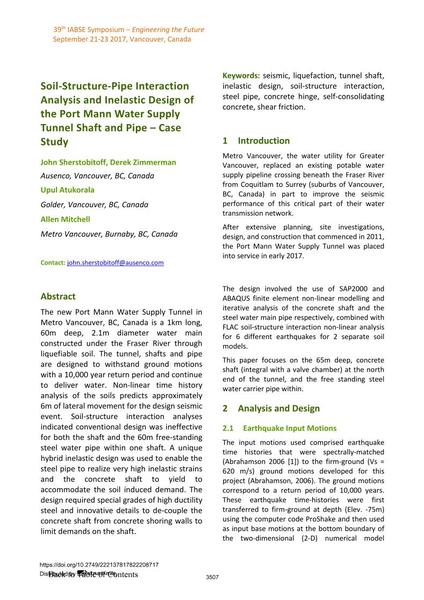Soil-Structure-Pipe Interaction Analysis and Inelastic Design of the Port Mann Water Supply Tunnel Shaft and Pipe – Case Study

|
|
|||||||||||
Bibliografische Angaben
| Autor(en): |
John Sherstobitoff
(Ausenco, Vancouver, BC, Canada)
Derek Zimmerman (Ausenco, Vancouver, BC, Canada) Upul Atukorala (Golder, Vancouver, BC, Canada) Allen Mitchell (Metro Vancouver, Burnaby, BC, Canada) |
||||
|---|---|---|---|---|---|
| Medium: | Tagungsbeitrag | ||||
| Sprache(n): | Englisch | ||||
| Tagung: | IABSE Symposium: Engineering the Future, Vancouver, Canada, 21-23 September 2017 | ||||
| Veröffentlicht in: | IABSE Symposium Vancouver 2017 | ||||
|
|||||
| Seite(n): | 3507-3513 | ||||
| Anzahl der Seiten (im PDF): | 7 | ||||
| Jahr: | 2017 | ||||
| DOI: | 10.2749/222137817822208717 | ||||
| Abstrakt: |
The new Port Mann Water Supply Tunnel in Metro Vancouver, BC, Canada is a 1km long, 60m deep, 2.1m diameter water main constructed under the Fraser River through liquefiable soil. The tunnel, shafts and pipe are designed to withstand ground motions with a 10,000 year return period and continue to deliver water. Non-linear time history analysis of the soils predicts approximately 6m of lateral movement for the design seismic event. Soil-structure interaction analyses indicated conventional design was ineffective for both the shaft and the 60m free-standing steel water pipe within one shaft. A unique hybrid inelastic design was used to enable the steel pipe to realize very high inelastic strains and the concrete shaft to yield to accommodate the soil induced demand. The design required special grades of high ductility steel and innovative details to de-couple the concrete shaft from concrete shoring walls to limit demands on the shaft. |
||||
| Stichwörter: |
Liquefaktion Boden-Bauwerk-Interaktion Betongelenk
|
||||
